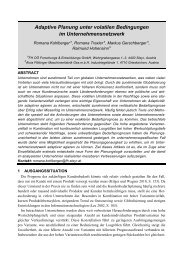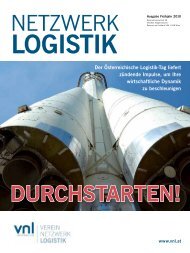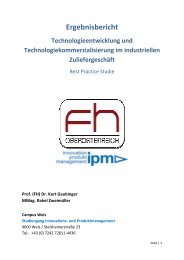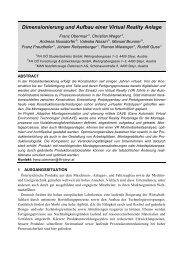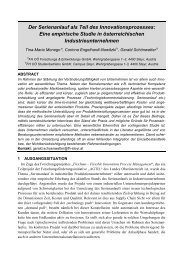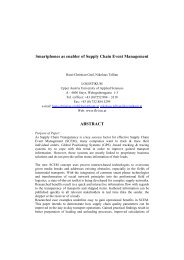a sustainable-oriented technology - agtil
a sustainable-oriented technology - agtil
a sustainable-oriented technology - agtil
You also want an ePaper? Increase the reach of your titles
YUMPU automatically turns print PDFs into web optimized ePapers that Google loves.
were the 15% of the sample with the highest scores on <strong>technology</strong> innovativeness, “low performers”<br />
were those 15% who had the lowest scores, and the remaining companies were grouped into<br />
the “middle performers” class. In the following exemplary analysis the results of the pilot study are<br />
shown. In particular, <strong>sustainable</strong> aspects of TD are focused and their impact on the success of suppliers<br />
is analyzed.<br />
4 FINDINGS - STUDY 1<br />
Our exploratory analysis revealed four key findings. First we recognized the importance of the<br />
strategic orientation of innovation and development activities to the company`s vision and business<br />
objectives.Second, a certain structuring of idea management is considered critical to success, as a<br />
way to identify those ideas which display a good strategic fit and potential.Third, it was generally<br />
observed that there had been a predominance of process-<strong>oriented</strong> TD. Forth, a process-related planning<br />
and implementation of commercial activities was underrepresented, instead an "intuitive approach"<br />
was dominant. These four key points are detailed below.<br />
• Strategic Planning: In conjunction with the reevaluation and reorientation of the innovation<br />
strategy an annual or semi-annual strategy meeting is anchored in most companies surveyed.<br />
Consistent with the literature the planning activities of the large companies are broader than<br />
those of the medium-sized companies. This can be seen from the ways in which information is<br />
gathered and, in particular, prepared and the strategic planning instruments, such as <strong>technology</strong><br />
and innovation portfolios, scenario techniques, <strong>technology</strong> issue analysis, etc. However, medium<br />
sized companies also carry out strategic situational analysis by using analyzing tools like<br />
SWOT analyses, trend analyses and competitive analyses, although to a lesser extent than the<br />
large firms surveyed. In the view of the interviewees these top-down activities are important, to<br />
take into account a strategy focused generation of ideas.<br />
• Idea Management: It was generally observed that innovative suppliers work not only with internal<br />
but particularly with a wide range of external sources of information and ideas. Consistent<br />
with Cooper`s research results, qualitative criteria are employed at the beginning of TD<br />
projects to evaluate <strong>technology</strong> ideas in interdisciplinary teams. Checklists, which enable a systematic<br />
approach to idea evaluation, were primarily used as assessment tools. In contrast, decision<br />
matrices and purely verbal assessments of <strong>technology</strong> ideas were seldom used. Differences<br />
in assessment also became visible by the numbers of assessment levels, which are undertaken,<br />
before ideas were turned into concrete development projects. The empirical research indicates<br />
that a two-step evaluation procedure is most popular, where the <strong>technology</strong> ideas are first assessed<br />
by an interdisciplinary team (prioritization), and those ideas that pass the first step are<br />
further assessed by the management that makes a selection decision (choice).<br />
• Technology Development: According to the research results, it has become evident that a systematic<br />
planning and implementation of development activities is of major importance for both<br />
the reduction in development time and speed up rapid pace of the introductory phase. The findings<br />
show that the logic of the Stage-Gate process with fuzzy gates (Cooper 2007) dominates in<br />
order to systematize the development activities (n=8). However, three companies surveyed use<br />
classical project structure plans for project planning and control, which are similar to Stage-<br />
Gate processes again. As a result of the specific characteristics of enterprises the structure of<br />
the TD processes provides varied differences. Firstly these distinctions relate to the number of<br />
process stages, which range from 3 to 13 phases and secondly, they are based on whether a dif-



